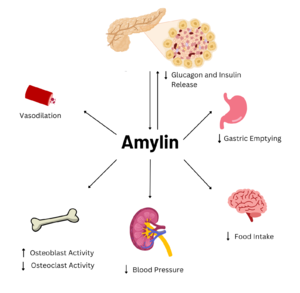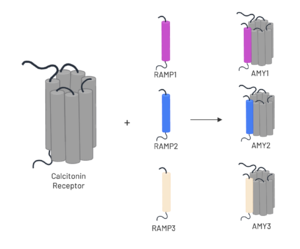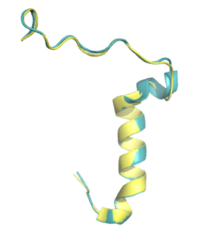User:Brynn Baker/Sandbox1
From Proteopedia
(Difference between revisions)
| Line 38: | Line 38: | ||
=== R18 === | === R18 === | ||
<scene name='10/1037516/R18/4'>R18</scene> lies at the C-terminal end of the main alpha helix and can adopt two different configurations. The “upper” configuration provides stronger interactions with various residues on the calcitonin receptor and is potentially what causes the helix to terminate around R18. Specifically, R18 interacts with the sidechain of D97 and the backbones of F99, P100, and F102. The latter three residues may also form van der Waals interactions and pi stacking with each other<ref name="Cao">PMID:35324283</ref>. | <scene name='10/1037516/R18/4'>R18</scene> lies at the C-terminal end of the main alpha helix and can adopt two different configurations. The “upper” configuration provides stronger interactions with various residues on the calcitonin receptor and is potentially what causes the helix to terminate around R18. Specifically, R18 interacts with the sidechain of D97 and the backbones of F99, P100, and F102. The latter three residues may also form van der Waals interactions and pi stacking with each other<ref name="Cao">PMID:35324283</ref>. | ||
| + | === S19 === | ||
| + | S19 is highly conserved in most observed variants of amylin<ref name="Bower">PMID:27061187</ref>. The sidechain of S19 hydrogen bonds to the backbone of P100 of CT <ref name="Cao">PMID:35324283</ref>. | ||
=== T9 Water Network === | === T9 Water Network === | ||
Threonine 9 is an essential residue for stabilization of amylin in the receptor, as its side chain is polar which allows it to hydrogen bond with other nearby polar groups, leading to extensive networks of interactions. T9 interacts with the <scene name='10/1038871/T9_main_chain/8'>main chains of Y191, M230, I380, and H381</scene> of the calcitonin receptor and many surrounding water molecules, but it also interacts with the <scene name='10/1038871/T9_network/1'>side chain atoms of S159, N194, S195, H226, N233, and Q383</scene>. All of these interactions create a very strong interaction between amylin and the receptor. The water network also helps stabilize the active receptor conformation. | Threonine 9 is an essential residue for stabilization of amylin in the receptor, as its side chain is polar which allows it to hydrogen bond with other nearby polar groups, leading to extensive networks of interactions. T9 interacts with the <scene name='10/1038871/T9_main_chain/8'>main chains of Y191, M230, I380, and H381</scene> of the calcitonin receptor and many surrounding water molecules, but it also interacts with the <scene name='10/1038871/T9_network/1'>side chain atoms of S159, N194, S195, H226, N233, and Q383</scene>. All of these interactions create a very strong interaction between amylin and the receptor. The water network also helps stabilize the active receptor conformation. | ||
Revision as of 21:17, 21 April 2024
Homo sapiens Amylin3 Receptor, AMYR3
| |||||||||||
References
- ↑ Hay DL, Chen S, Lutz TA, Parkes DG, Roth JD. Amylin: Pharmacology, Physiology, and Clinical Potential. Pharmacol Rev. 2015 Jul;67(3):564-600. PMID:26071095 doi:10.1124/pr.115.010629
- ↑ 2.0 2.1 Grizzanti J, Corrigan R, Casadesus G. Neuroprotective Effects of Amylin Analogues on Alzheimer's Disease Pathogenesis and Cognition. J Alzheimers Dis. 2018;66(1):11-23. PMID:30282360 doi:10.3233/JAD-180433
- ↑ 3.00 3.01 3.02 3.03 3.04 3.05 3.06 3.07 3.08 3.09 3.10 Cao J, Belousoff MJ, Liang YL, Johnson RM, Josephs TM, Fletcher MM, Christopoulos A, Hay DL, Danev R, Wootten D, Sexton PM. A structural basis for amylin receptor phenotype. Science. 2022 Mar 25;375(6587):eabm9609. PMID:35324283 doi:10.1126/science.abm9609
- ↑ 4.0 4.1 Bower RL, Hay DL. Amylin structure-function relationships and receptor pharmacology: implications for amylin mimetic drug development. Br J Pharmacol. 2016 Jun;173(12):1883-98. PMID:27061187 doi:10.1111/bph.13496
Student Contributors
- Brynn Baker
- Emily Berkman
- Sepp Hall



